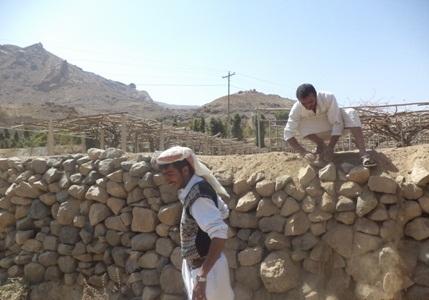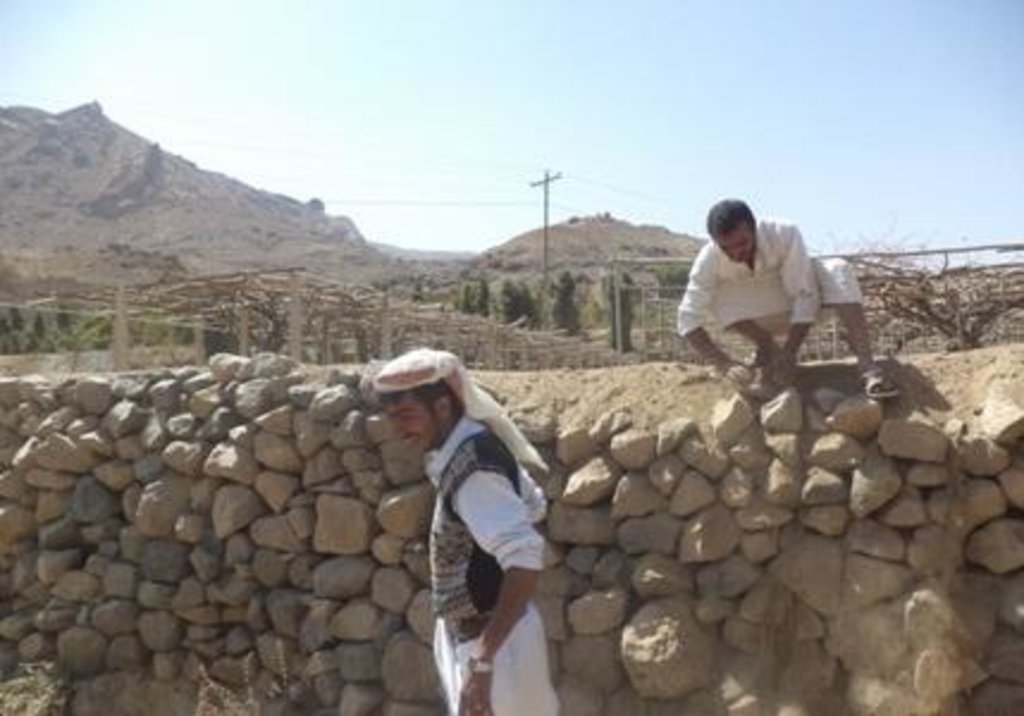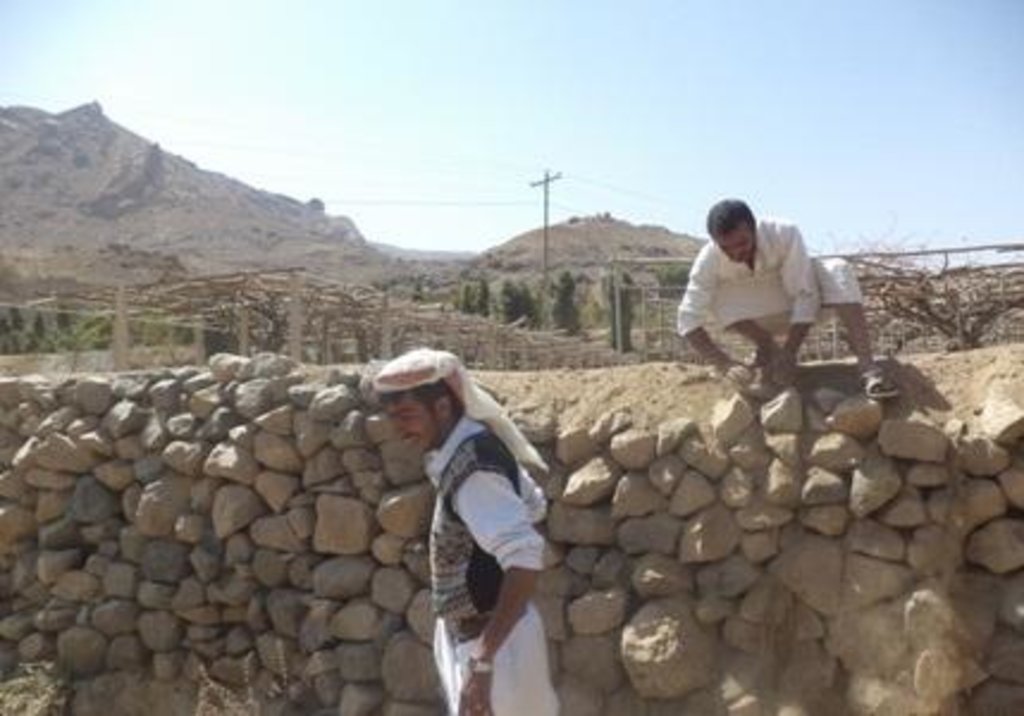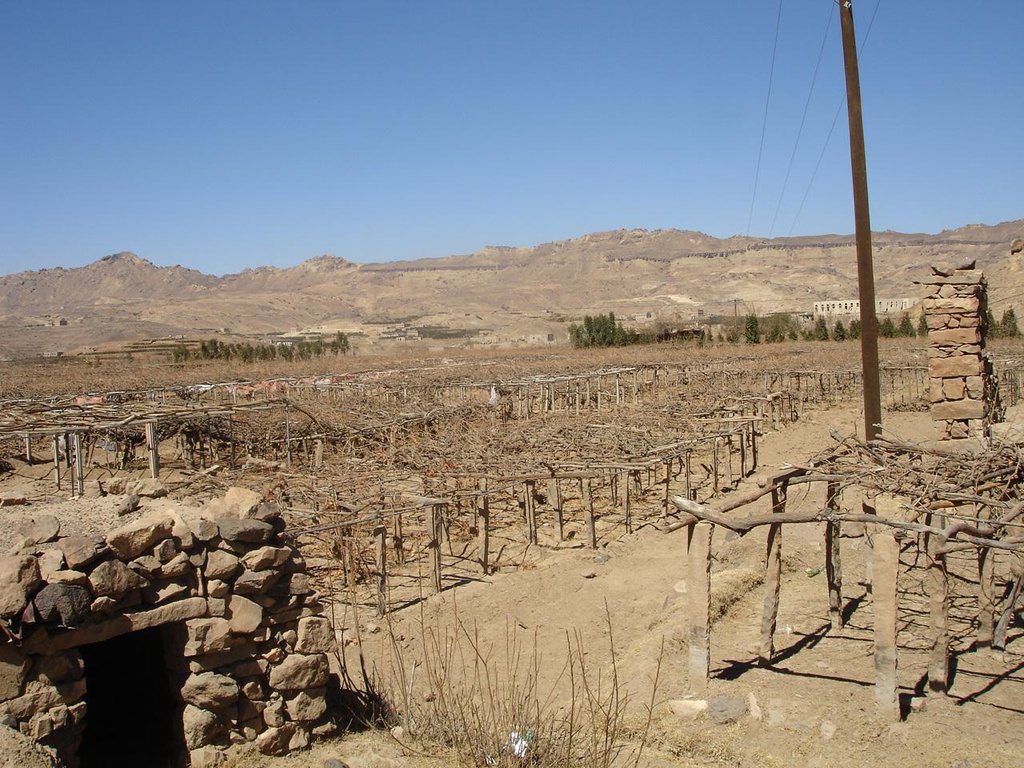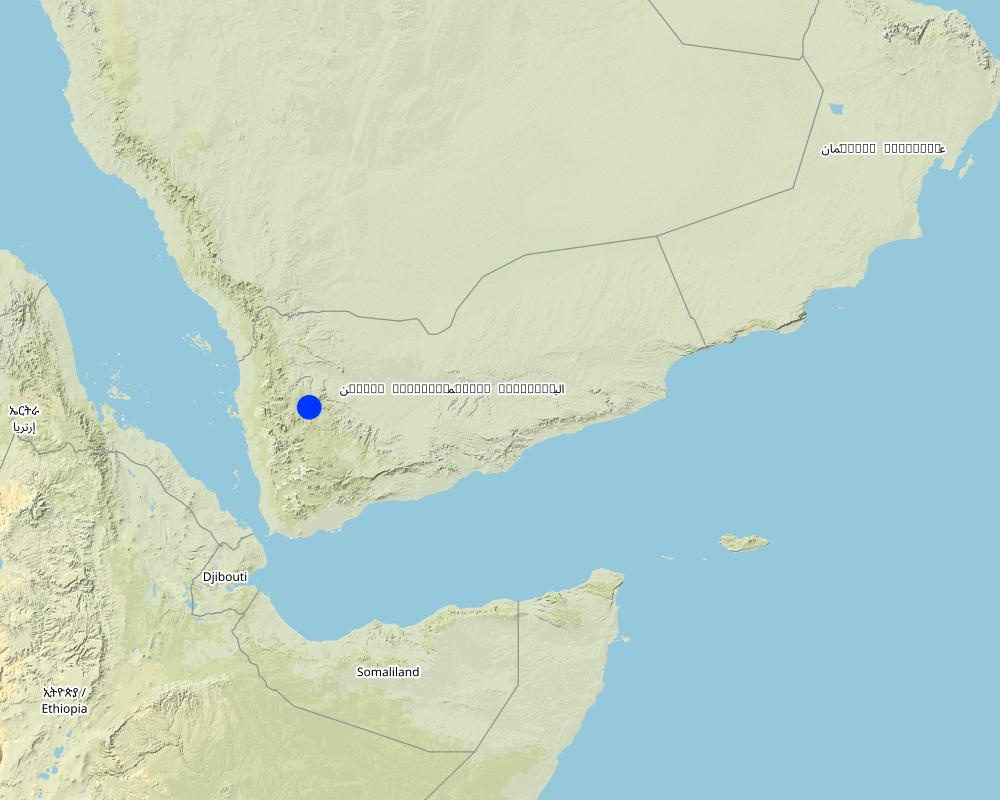Rehabilitation of terraces and diversion construction with gates and channels [เยเมน]
- ผู้สร้างสรรค์:
- การอัพเดท:
- ผู้รวบรวม: ahmed algalal
- ผู้เรียบเรียง: –
- ผู้ตรวจสอบ: Fabian Ottiger, Joana Eichenberger
إعادة تأهيل المدرجات والحواجز والبوابات والسواقي
approaches_2635 - เยเมน
ดูส่วนย่อย
ขยายทั้งหมด ย่อทั้งหมด1. ข้อมูลทั่วไป
1.2 รายละเอียดที่ติดต่อได้ของผู้รวบรวมและองค์กรที่เกี่ยวข้องในการประเมินและการจัดเตรียมทำเอกสารของแนวทาง
ผู้เชี่ยวชาญ SLM:
Alhadrami Yahya
00967777249274
General Directorate for irrigation
Sanaa
เยเมน
ผู้เชี่ยวชาญ SLM:
Sallam Ahmed
Agricultural Research and Extension Authority, AREA
เยเมน
ชื่อของโครงการซึ่งอำนวยความสะดวกในการทำเอกสารหรือการประเมินแนวทาง (ถ้าเกี่ยวข้อง)
Agricultural Research and Extension Authority (AREA) - เยเมน1.3 เงื่อนไขที่เกี่ยวข้องกับการใช้ข้อมูลที่ได้บันทึกไว้ผ่านทาง WOCAT
วันที่เก็บรวบรวมข้อมูล (ภาคสนาม):
15/02/2013
ผู้รวบรวมและวิทยากรหลักยอมรับเงื่อนไขเกี่ยวกับการใช้ข้อมูลที่ถูกบันทึกผ่านทาง WOCAT:
ใช่
1.4 การอ้างอิงถึงแบบสอบถามเรื่องเทคโนโลยี SLM
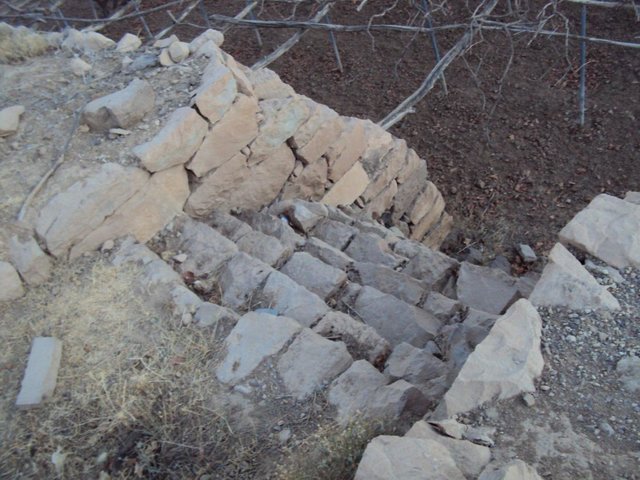
Building Walls's stones to protect lands and building … [เยเมน]
use the stones to build walls around agricultural terraces to protect them from erosion and make outlets (Spillway) to discharge excess water and prevent the destruction of the stands
- ผู้รวบรวม: ahmed algalal
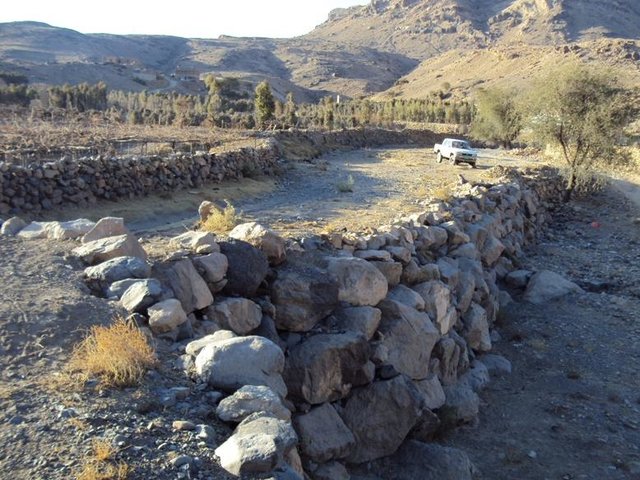
Diversion construction with gates and distribution channels [เยเมน]
The stone existed in the region are used for building diversion constructions to raise the level of wadi bed to the level of the inlet of the cultivated land that need to be irrigated from water harvesting in addition to distribution channels in the fields
- ผู้รวบรวม: ahmed algalal
2. คำอธิบายของแนวทาง SLM
2.1 การอธิบายแบบสั้น ๆ ของแนวทาง
The rehabilitation of walls and outlets of the terraces and diversion construction with accessories from channels and gates are carried out by the local community in a regular way
2.2 การอธิบายอย่างละเอียดของแนวทาง
การอธิบายอย่างละเอียดของแนวทาง:
Aims / objectives: Before 56 years the cultivated land were stable and sustainable as a result of application the technologies. However, in 1956 a severe flood occurred had let to washed a large area of the cultivated land and people and houses. Then the local community had decided to puts hands together and started to rebuilt all the walls and gates and outlet of the whole terraces that damages from hoods. That was because the cultivated land was the only main source of livelihood at that time. The first step made by the local community are meeting at the invitation of sensible to consult and agree on how to rebuild what has been flashed as a result of floods and determine the priority of work and methods of implementation, it was agreed that the owner where damage event happened should do not pay anything either bring drinking water to the people who attended to assist him. However, first to protect agricultural land prone to erosion In the event of second rainstorm located on the main course Flood water (riparian valley). Then be re-construction of the barrier with accessories.
Key stages
1 - The land users involved in a specific area (position) to collect stones necessary to rebuild the walls of the garrison of land and after processing quantity required by the land users are re-building walls collectively by the community of males, contributing to work both reached 12 years of age male. Were identified on Friday of each week to carry out the construction is completed collecting the required stones.
2 - Settlement of the surface of the soil and filling eroded canyons and remove sediment from agricultural land by land users
3 - grape planting trees in areas affected by erosion
4 - building barriers gradually until they reach the level of agricultural land to be irrigated from the barrier and building gates and canals by the users of the land beneficiaries of the barrier
For agricultural land away from the waterway has been rehabilitated and build by the users of the land due to lack of manpower where everyone is busy their land to address the damage that occurred, and as a result was rebuilt stone walls in places exposed to the risk of erosion and the work of the walls of the soil in places less dangerous .
2.3 รูปภาพของแนวทาง
2.5 ประเทศ ภูมิภาค หรือสถานที่ตั้งที่ได้นำแนวทางไปใช้
ประเทศ:
เยเมน
ภูมิภาค/รัฐ/จังหวัด: :
Sana'a governorate
ข้อมูลเฉพาะเพิ่มเติมของสถานที่ตั้ง:
Bani Hushaish district
Map
×2.6 วันที่เริ่มต้นและสิ้นสุดของแนวทาง
ระบุปีที่เริ่ม:
1956
2.7 ประเภทของแนวทาง
- แบบดั้งเดิม/ แบบพื้นเมิอง
2.8 เป้าหมายหรือวัตถุประสงค์หลักของแนวทาง
The Approach focused mainly on other activities than SLM (Getting benefits from water harvesting in irrigation terraces )
Rehabilitation of terraces and protect it from water damages through or follow the indigenous knowledge that was followed to maintain the terraces. And at the same time harvesting water.
The SLM Approach addressed the following problems: land degradation and maintain the traditional techniques, improve agricultural production
2.9 เงื่อนไขที่เอื้ออำนวยหรือเป็นอุปสรรคต่อการนำเทคโนโลยีภายใต้แนวทางนี้ไปปฏิบัติใช้
บรรทัดฐานและค่านิยมทางสังคม วัฒนธรรม ศาสนา
- เป็นอุปสรรค
Lack of finance
Treatment through the SLM Approach: use available resource in the region
กรอบแนวทางในการดำเนินการด้านกฎหมาย (การถือครองที่ดิน สิทธิในการใช้ที่ดินและน้ำ)
- เอื้ออำนวย
The existing land ownership, land use rights / water rights greatly helped the approach implementation: all the land was returned to its original borders was interaction in the implementation process in a positive way and did not happen leads boiling obstruct the implementation process
ปริมาณงานที่ทำได้ กำลังคนที่มีให้
- เป็นอุปสรรค
Hard work and lack of labours
Treatment through the SLM Approach: Grouping together to rebuild the break down walls of stone of the terraces (with no money as a help)
3. การมีส่วนร่วมและบทบาทของผู้มีส่วนได้ส่วนเสียที่เกี่ยวข้อง
3.1 ผู้มีส่วนได้ส่วนเสียที่เกี่ยวข้องในแนวทางนี้และบทบาท
- ผู้ใช้ที่ดินระดับท้องถิ่นหรือชุมชนระดับท้องถิ่น
Males over 12 years old
The local community they work collectively and in a positive and self-funded (self-effort) used the available resources available in the region. Approach involves the entire community in all social classes.
- รัฐบาลแห่งชาติ (ผู้วางแผน ผู้ทำการตัดสินใจ)
ถ้ามีผู้มีส่วนได้ส่วนเสียหลายคนที่เกี่ยวข้องให้ระบุหน่วยงานตัวแทน:
It came be done through meetings and discussion to select the best method for implementation.
3.2 การเกี่ยวข้องของผู้ใช้ที่ดินระดับท้องถิ่นหรือชุมชนระดับท้องถิ่นในช่วงต่างๆของแนวทาง
| ความเกี่ยวข้องของผู้ใช้ที่ดินระดับท้องถิ่นหรือชุมชนระดับท้องถิ่น | ระบุผู้ที่มีส่วนเกี่ยวข้องและอธิบายกิจกรรม | |
|---|---|---|
| การริเริ่มหรือการจูงใจ | ไม่มี | |
| การวางแผน | ไม่มี | |
| การดำเนินการ | ไม่มี | |
| การติดตามตรวจสอบหรือการประเมินผล | ไม่มี | |
| Research | ไม่มี |
3.4 การตัดสินใจเลือกใช้เทคโนโลยี SLM
ระบุผู้ที่ทำการตัดสินใจเลือกเทคโนโลยีมากกว่าหนึ่งวิธีไปปฏิบัติใช้:
- ผู้ใช้ที่ดินเพียงผู้เดียว ( ริเริ่มด้วยตัวเอง)
การอธิบาย:
Exchange experiences especially of what concern of indigenous knowledge to activate them because they are practical and most the farmers familiar with them
Decisions on the method of implementing the SLM Technology were made by by land users* alone (self-initiative / bottom-up)
4. การสนับสนุนด้านเทคนิค การสร้างขีดความสามารถ และการจัดการด้านความรู้
4.1 การสร้างขีดความสามารถ / การอบรม
ได้มีการจัดอบรมให้แก่ผู้ใช้ที่ดินหรือผู้มีส่วนได้ส่วนเสียคนอื่น ๆ หรือไม่:
ไม่ใช่
4.3 การเสริมความแข็งแกร่งให้กับสถาบัน (การพัฒนาองค์กร)
สถาบันได้รับการจัดตั้งขึ้นมาหรือเสริมความแข็งแกร่งโดยแนวทางนี้หรือไม่:
- ไม่
4.4 การติดตามตรวจสอบและประเมินผล
การติดตามตรวจสอบและประเมินผลเป็นส่วนหนึ่งของแนวทางหรือไม่:
ใช่
ความคิดเห็น:
bio-physical aspects were ad hoc monitored by land users through observations
technical aspects were regular monitored by land users through observations
area treated aspects were ad hoc monitored by other through observations
There were no changes in the Approach as a result of monitoring and evaluation
There were no changes in the Technology as a result of monitoring and evaluation
4.5 การวิจัย
การวิจัยเป็นส่วนหนึ่งของแนวทางหรือไม่:
ไม่ใช่
5. การสนับสนุนด้านการเงินและวัสดุอุปกรณ์
5.1 ระบุงบประมาณประจำปีสำหรับแนวทาง SLM นี้
ถ้าหากว่างบประมาณประจำปีไม่เป็นที่ทราบแน่นอน ให้ระบุช่วงลงไป:
- 2,000-10,000
แสดงความคิดเห็น (แหล่งของการระดมทุน ผู้บริจาคคนสำคัญ):
Approach costs were met by the following donors: local community / land user(s) (The local community should be responsible for cost of the approaches and technology): 100.0%
5.2 การสนับสนุนด้านการเงิน / วัสดุอุปกรณ์ให้แก่ผู้ใช้ที่ดิน
ผู้ใช้ที่ดินได้รับการสนับสนุนด้านการเงิน / วัสดุอุปกรณ์ไปปฏิบัติใช้เทคโนโลยีหรือไม่:
ไม่ใช่
5.4 เครดิต
มีการจัดหาเครดิตมาให้ภายใต้แนวทาง SLM หรือไม่:
ไม่ใช่
6. การวิเคราะห์ผลกระทบและการสรุป
6.1 ผลกระทบของแนวทาง
ช่วยให้ผู้ใช้ที่ดินนำเอาเทคโนโลยี SLMไปใช้และบำรุงรักษาสภาพไว้ได้หรือไม่:
- ไม่ใช่
- ใช่ เล็กน้อย
- ใช่ ปานกลาง
- ใช่ อย่างมาก
protect the land from erosion and drought mitigation
Did other land users / projects adopt the Approach?
- ไม่ใช่
- ใช่ เล็กน้อย
- ใช่ ปานกลาง
- ใช่ อย่างมาก
Did the Approach lead to improved livelihoods / human well-being?
- ไม่ใช่
- ใช่ เล็กน้อย
- ใช่ ปานกลาง
- ใช่ อย่างมาก
increased productivity as a result of the availability of irrigation water, reduce maintenance costs and maintain on the ground
Did the Approach help to alleviate poverty?
- ไม่ใช่
- ใช่ เล็กน้อย
- ใช่ ปานกลาง
- ใช่ อย่างมาก
by increasing the rate of production and hence poverty alleviation
6.2 แรงจูงใจหลักของผู้ใช้ที่ดินเพื่อที่จะนำ SLM ไปปฏิบัติใช้
- การผลิตที่เพิ่มขึ้น
Increase the amount of production
- จิตสำนึกด้านสิ่งแวดล้อม
- Protect the land from erosion
ِِAs a result of floods
- Drought mitigation
Increase soil moisture
6.3 ความยั่งยืนของกิจกรรมของแนวทาง
ผู้ใช้ที่ดินสามารถทำให้สิ่งต่างๆ ที่ได้ปฏิบัติใช้โดยแนวทางนี้ยั่งยืนได้หรือไม่ (โดยไม่มีการสนับสนุนจากภายนอก):
- ไม่
ถ้าตอบว่าไม่หรือไม่แน่ใจ ให้ระบุและแสดงความคิดเห็น :
- Find easy ways to do the production process, even at the expense of resources of future generations, the most important ground water that drains a result of drilling wells for the purpose of irrigation, which led to the neglect of maintenance operations may not be great at the present time, but may increase in the future, leading to the extinction of these techniques
6.4 จุดแข็งและข้อได้เปรียบของแนวทาง
| จุดแข็ง / ข้อได้เปรียบของแนวทางในทัศนคติของผู้รวบรวมหรือวิทยากรหลัก |
|---|
| The rehabilitation of degraded agri terraces were carried out by the local farmers who constitute a teamwork (How to sustain/ enhance this strength: Development of domestic legislation and to ensure the continued support of collective action) |
| building techniques using the resources available in the region |
7. การอ้างอิงและการเชื่อมต่อ
7.1 วิธีการหรือแหล่งข้อมูล
- ไปเยี่ยมชมภาคสนาม การสำรวจพื้นที่ภาคสนาม
- การสัมภาษณ์กับผู้ใช้ที่ดิน
7.2 การอ้างอิงถึงสิ่งตีพิมพ์
ชื่อเรื่อง ผู้เขียน ปี ISBN:
Report of traditional knowledge and customs (sallam, et al, 2008)
ช่องทางในการสืบค้น และราคา:
Agricultural Research and Extension Authority, AREA
ลิงก์และโมดูล
ขยายทั้งหมด ย่อทั้งหมดลิงก์

Building Walls's stones to protect lands and building … [เยเมน]
use the stones to build walls around agricultural terraces to protect them from erosion and make outlets (Spillway) to discharge excess water and prevent the destruction of the stands
- ผู้รวบรวม: ahmed algalal

Diversion construction with gates and distribution channels [เยเมน]
The stone existed in the region are used for building diversion constructions to raise the level of wadi bed to the level of the inlet of the cultivated land that need to be irrigated from water harvesting in addition to distribution channels in the fields
- ผู้รวบรวม: ahmed algalal
โมดูล
ไม่มีโมดูล


